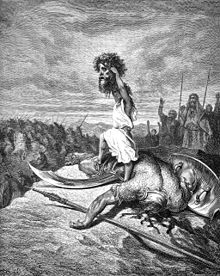This is an old revision of this page, as edited by Rapi'uma (talk | contribs) at 00:25, 3 November 2008. The present address (URL) is a permanent link to this revision, which may differ significantly from the current revision.
Revision as of 00:25, 3 November 2008 by Rapi'uma (talk | contribs)(diff) ← Previous revision | Latest revision (diff) | Newer revision → (diff)
In the Hebrew Bible (Christian "Old Testament") the term "Rephaim" (Heb. plural רפאים; "Rephaite" would be the English translation of this term as though it referred to residents of a certain region, which is one use of the term in the HB/OT) has two primary meanings:
1. "Rephaim" can describe an ancient "race" of giants in Iron Age Israel/Palestine, or the places where these individuals were thought to have lived: see Gen. 14:5, 15:20; Deut. 2:10-1,20, 3:11,13; Josh. 12:4, 13:12, 15:8, 17:15, 18:16; 2Sam. 5:11,22, 23:13; 1Chr. 11:15, 14:9, 20:4. In the biblical narrative, the Israelites are instructed to exterminate the previous inhabitants of the "promised land," i.e. "Canaan," which include various named peoples, including some unusually tall/large individuals. See the passages listed above in the book of Joshua, and also Deut. 3:11, which implies that Og, the King of Bashan, was one of the last survivors of the Rephaim, and that his bed was 9 cubits long (i.e., about 18 feet/5 meters, implying he was a giant). C.f. the reference to Nephilim and the "sons of God" in Gen. 6:1-3. The famous Philistine giant Goliath would seem to fit into this paradigm of giants living in the land that must be slain by the Israelites in order to possess the land.
2. Rephaim can also refer to the residents of Sheol (a biblical term for the land of the dead in the HB/OT). See Isa. 14:9, 26:14,19; Ps. 88:11; Prov. 2:18, 9:18, 21:16; Job. 26:5; and possibly 2Chron. 16:12, where we may read “Repha'im,” i.e. "dead ancestors," as opposed to Rophe’im, “doctors." The Heb. root רפא means "heal," and thus the masc. plural nominalized form of this root may indicate that these deceased ancestors could be invoked for ritual purposes that would benefit the living.
Note also that various ancient Northwest Semitic texts are replete with references to the Rephaim as the dead or dead kings; see KAI 13.7-8, 14.8, 177.1; CTA 6.6.46-52, CTA 20-22 = KTU 1.161 (see the article by M.S. Smith, “Rephaim,” in the Anchor Bible Dictionary). In the very thorough study of T.J. Lewis (professor of Hebrew Bible at Johns Hopkins University), Cults of the Dead in Ancient Israel and Ugarit (Scholars Press, 1989), Lewis undertakes a detailed study of several enigmatic funerary ritual texts from the ancient coastal city of Ugarit. Lewis concludes that the "Ugaritic Funerary Text" (KTU 1.161 = RS 34.126) provides important evidence for understanding Ugarit's cult of the dead, wherein beings called rapi'uma, the long dead, and malakuma, recently dead kings, were invoked in a funeral liturgy, presented with food/drink offerings, and asked to provide blessings for the reign of the current king. The many references to repha'im in the HB/OT in contexts involving Sheol and dead spirits strongly suggests that many ancient Israelites imagined the spirits of the dead as playing an active and important role in securing blessings, healing, or other benefits in the lives of the living. On the role of the dead and burial customs in ancient Israelite society and the cultures of ancient Syro-Palestine generally, see L. Bloch-Smith's Judahite Burial Practices and Beliefs About the Dead (Continuum, 1992).